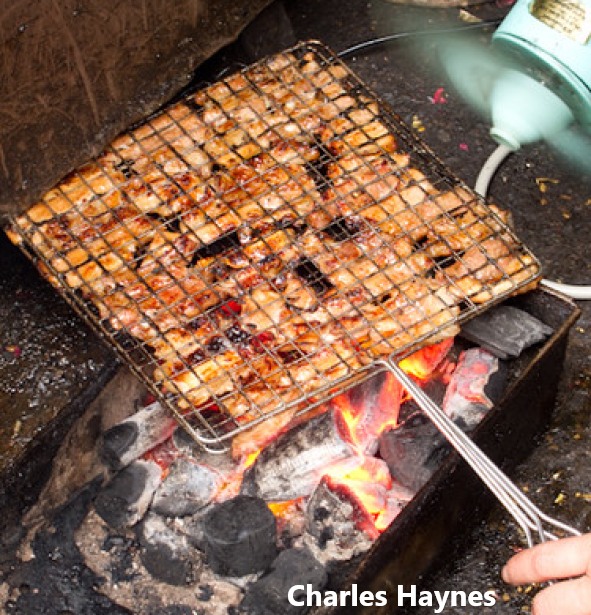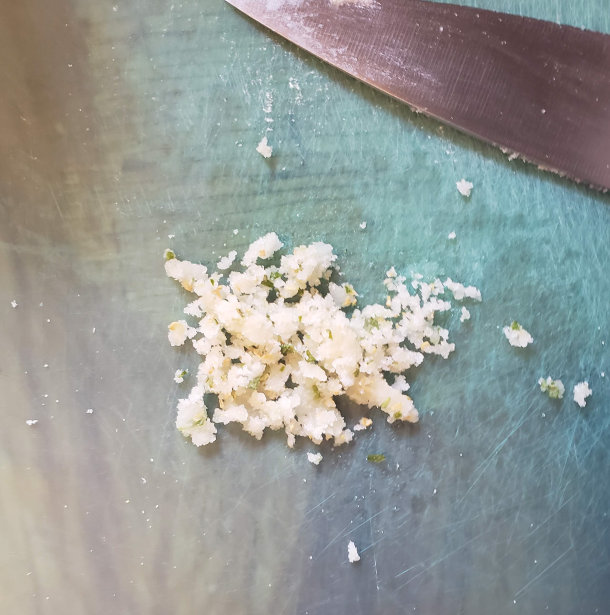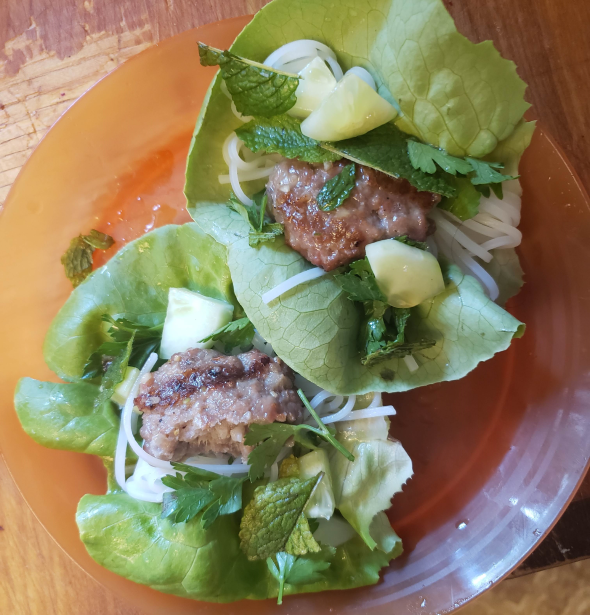KC 226 – Cheater’s Bun Cha

Why hello there, and welcome back to Kitchen Catastrophe, where we fuck up food so you don’t have to. I’m your Teaching-Through-Terrible-Tutor, Jon O’Guin, and luckily for me, today’s recipe isn’t all that terrible. It IS a little weird, though, and uses a technique I’ve never encountered, so I wanted to bring it to you all. If you just need to get cooking, here’s the link. For everyone else, let’s get down to bun cha.
Bet-Cha Won’t Eat Just One
That was one of the MORE workshopped Title Jon riffs we’ve had in years, with a full THREE attempts to make the “cha”-pun land. Anywho, Bun cha is a recipe with a very simple name, some pretty simple ingredients, and generally not a lot going on under the hood, so to speak. The name literally translates to “(fatty) pork with rice noodles”. That’s it. “Pork Noodles”. But, such simple scions are not to be dismissed, as anyone who’s watched the movie Chef, or watched enough Binging with Babish can tell you, pasta aglio e olio is a similarly simple dish with AMAZING results, despite being… “Garlic and Oil Pasta”.
Chef goes so far as to imply that THIS PASTA is good enough to maybe get Scarlett Johansson to want to sleep with you.
Similarly, while bun cha might not have the most impressive name, and its arrangement might be pretty simple, that’s not to say it can’t impress. It is considered by many to be the signature dish of Hanoi, the capital of Vietnam. It is a dish eaten mostly at lunch, but in growing numbers throughout the day, by millions of Vietnamese people from all walks of life. And it was, somewhat famously, eaten by two NON-Vietnamese men in 2016.
Gangster Anderson Cooper and Don Lemon?
That’s Barack Obama and Anthony Bourdain, sharing a bowl of Bun Cha, which Bourdain is introducing to the then-President. It was part of Bourdain’s show, Parts Unknown. It was a moment and interaction that Bourdain was effusive about, discussing what it was like to talk with the President in such a setting, and a moment Obama used to memorialize Bourdain after his tragic passing.
It also totally fucks up the recipe I’m going to give you.
Not in the sense that they’re making it WRONG there, god no. I am not about to start slinging disparagement at a restaurant IN VIETNAM making a Vietnamese dish “wrong”, I’m not INSANE. Starting turf wars in Vietnam has historically RUINED thousands of Americans’ lives, and I will NOT be joining them today. What I mean is that makes MINE look wrong, because of regional differences: Hanoi is located in Northern Vietnam, and they eat the dish essentially as a soup: the pork and some vegetables sit in a thin broth/sauce of vinegar, fish sauce, and sugar, and you stir in chilies, herbs and greens, and noodles as you see fit. Somewhat akin to what you might experience with Pho, where the noodles and meat are in the broth, but you’re provided limes, chili sauce, herbs, sprouts, etc.
Now I want some Pho, damn it.
MY recipe is based on a version of the dish from SOUTHERN Vietnam, where it’s prepared somewhat like Bún thịt nướng (a series of words I am sure Audio Jon is certain to enjoy having to learn to pronounce even VAGUELY correctly) which is closer to a salad or a lettuce-wrap situation. I think this is because the flavors involved are easier to SELL to Americans, where the idea of “a broth of vinegar, fish sauce, and sugar” may sound more than a little off-putting. However, I think it holds a lot of the same ideas, and even taps into that soup-style of cooking for one of its neater tricks.
So, with that out of the way, how does it work? Well, in Vietnam, they would typically use two kinds of pork: pork meatballs, or thin slices of pork belly. The better restaurants would use BOTH, but you could also order with one or the other, the idea being that the fairly soft meatballs would contrast with the cracklier, crunchier pork belly. This version only uses the meatballs, because it’s harder for most Americans to find good pork belly sources they can trust, and because if you take out the “cook two types of pork different ways”, you can make a meal that’s ready in theoretically about 30 minutes. Sometimes ya gotta cut the cracklin’ for…quickness? I don’t know why I felt that should be alliterative.
I guess as a sort of onomatopoeia for the sound of the crackly pork belly?
Now, I’m going to SAY “That’s really all I have to talk about with this dish”, and when I do that, just nod along for the minute, will you? Because yes, we all know I’m going to A: write about actually MAKING it, and B: I will break that promise later. But it’s because I want to present this to you in the right way. SO…”That’s really all I have to say about this dish, so let’s get cooking”.
Nod and Smile
So the beginning of this process is actually pretty simple, which is a thing I say a lot in these posts, for three main reasons: by telling YOU it’s simple, I hopefully make it more approachable. By admitting it’s simple, I excuse myself for not picking more complicated recipes. And by praising its simplicity afterward, I can apologize to the recipe for procrastinating making it for several weeks because it felt like too much effort.
I humbly receive this…food I should have made two weeks ago.
Anywho, the recipe is basically: cook some noodles, make and cook some pork meatballs, SECRET COOL STEP, serve with chopped herbs, cooked noodles, and some lettuce leaves. So the first thing you need to do is make nuoc cham, because of course the first step has nothing to do with any of the listed steps.
Nuoc Cham is…The “burger sauce” of Vietnam, in the same way that nuoc mam (fish sauce) is Vietnam’s ketchup. The latter is the universal condiment found in almost every fast-food eatery, and the former is the shop-specific creations often (but not necessarily) using it as a base: Fry sauce, Big Mac sauce, Awesome Sauce, In-N-Out Sauce, Dick’s Sauce, Shake Shack Sauce, Comeback Sauce, etc etc (man, maybe I should do a post about burger sauces in America). And just as typically a burger sauce is SOME variation of “ketchup, mayo, maybe mustard, probably relish, and then the weird shit starts”, Nuoc Cham is typically: sugar, acid, water, fish sauce. The acid is typically lime juice, vinegar, or both. And you often toss in minced chili peppers or garlic, maybe some diced veggies like radish or carrot. This version is a middle-of-the-road one, that starts with making a paste with sugar, garlic, and Thai chili. To be truly authentic to the region, you’d mash them together in a mortar and pestle. But I apparently boxed mine up in a cargo trailer over a year ago, and didn’t have time to whip it out and smash this recipe. So instead, I just crushed the chili, garlic, and sugar with a knife to form “a Paste”. (I used quotes here because I ALSO don’t have the best Thai Chilies in the world: I’ve been using small ones that I froze for longevity, and they’re starting to dry out. Watching the original recipe (a step I maybe should have done BEFORE making the recipe, but I legitimately didn’t know it was in a video until today), their paste is MUCH wetter than mine ended up, because they used half of a MUCH larger chili. (This paragraph has had worryingly sexual undertones for a discussion about chili-paste. That will CHEMICALLY BURN YOU if you get it in the wrong place!)
Do not try to use this during intimate times. Hell, this is a little dry to be used in NON-intimate times.
Once you’ve gotten the paste as…pasty as you think you can, mix it into some hot water to fully dissolve the sugar, then add fish sauce and lime juice. Stir, and let sit for a while.
Next up, make the meatballs. This is also a pretty straight-forward process: mince a shallot, mix with sugar (there’s a LOT of salt and acid in the recipe which would, in Vietnam, be somewhat countered with the sweetness of the rice vinegar, and maybe of the fish sauce. Since we’re not using rice vinegar and American fish sauce is pretty non-sweet, we add sugar.), fish sauce, ground pepper, and baking soda.
I don’t typically get a lot of pictures of meat after it’s mixed together, since, you know, hands covered in meat.
Now, the baking soda’s going to do some things for us in this recipe. Like with the Lion’s Head Meatballs we made In the Before Times, the baking soda is going to allow the meatballs to retain more moisture, and give a light pink color to the inside of our meatballs. They OTHER thing it’s going to do is make our pork more basic (ha), which means it will brown better. Why is that important? Because we want nice browned and charred pieces of pork for the next step.
Anywho, get the meatballs formed (And at this point ,I want to note that this recipe comes from America’s Test Kitchen, and I specifically made the 2 serving version, but you can also just double the recipe for a 4 person mix), and get them on the grill for about 3-4 minutes per side. While Nate was handling that, I was handling the other important step of “boil some water to cook the noodles”, “chop up a cucumber” and “what do you mean the grill is out of gas?”
Which is partly why these look a little more like “pre-frozen burger patty” than “well-charred”.
So…yeah. We ran out of fuel partway through grilling our pork, which HAD to compromise the texture/char a little. But what can I say? These things happen. While Nate pulled the gas from a deck heating lamp to run the grill, I ran into the now-feral biosphere of our garden beds, and harvested some fresh mint, and also cut up some parsley, since I was already making Nate do something for more than 5 minutes, he’d have utterly refused if I also asked him to eat Cilantro.
Once the meatballs are grilled, it’s time for the SUPER SECRET STEP: Toss them in the nuoc cham, and let them sit for 5 minutes.
Very interesting in the theoretical sense, kinda boring in the visual sense.
THIS is the cool technique I mentioned wanting to expand on: the reverse-marinade. That’s how this dish is still incorporating the ideas of the Hanoi Soup-Style, and introducing an interesting new tool to grilling and other high-heat operations. One of the downsides to Marinades is that, just as making food more alkaline forces mixtures to hold more moisture, and brown better, acidic marinades often drain water from the food, and make it harder to get great browning or char. (This is one of the reasons many marinades use oil: it can minimize/replace lost liquid, either by being absorbed where the water was drained, or by preventing the water from leaking out.)
A reverse-marinade allows you to use flavors knowing they won’t be dulled by cooking, AND can even add flavors to the marinades: as the pork balls rest in the nuoc cham, they’re going to imbue it with charred, porky flavors, making it a better tasting sauce to sprinkle on the lettuce wraps. Imagine the same technique with, say, Tacos: make a mixture of lime juice, chili powder, cumin, and drizzle it over charred meats or veggies while they rest. You just slice up the seasoned centerfold, throw it in tortillas, and serve.
Speaking of, assuming your noodles have done, and you give them a quick cool-down rinse and pat-down dry…that’s it. You make one sauce, grill some meat, chop some veggies and boil some noodles. Simple. How are the results?
Visually, pretty cool. Though maybe I should have looked for some red chili peppers for a little extra punch of color.
They’re pretty good! There’s a couple little quibbles (I couldn’t get Bibb lettuce, so I used Butter, which are a little smaller, especially compared to the meatballs, and thus we struggled to keep all the “fillings” in, but everyone agreed the recipe tasted great, especially the meatballs and sauce. So if you want a simple introduction to Vietnamese food, or an alternative to a grilled burger that’s more veggie forward this summer, I recommend you get this a try! It’s… a BUN-CHA fun. (I literally didn’t think of that joke until just now.)
THURSDAY: THE BURGER SAUCE THING? A DISCUSSION OF THE MORTAR AND PESTLE THAT I WAS SUPPOSED TO USE? I DON’T KNOW.
MONDAY: I’M ALMOST CERTAINLY GOING TO BE DISCUSSING AN INTERESTING CHICKEN WING RECIPE. WARNING: IT’S GOING TO BE COMPLICATED.
Time to whip up this
Recipe
Cheater’s Bun Cha
Serves 2 (can be doubled)
Ingredients
Nuoc Cham
½ small Thai chile, stemmed and minced
1 ½ tablespoons sugar
1 small garlic clove, minced
⅓ cup hot tap water
2 ½ tablespoons fish sauce
2 tablespoons lime juice
Noodles and Salad
4 ounces rice vermicelli
½ head Boston lettuce (4 ounces), torn into bite-size pieces
½ English cucumbers, peeled, quartered lengthwise, seeded, and sliced thin on bias
½ cup fresh cilantro leaves and stems
½ cup fresh mint leaves, torn if large
Pork Patties
1 small shallot, minced
1 ½ teaspoons fish sauce
¾ teaspoon sugar
¼ teaspoon baking soda
¼ teaspoon pepper
8 ounces ground pork
Preparation
Make the Nuoc Cham: Grind together the garlic, thai chile, and sugar together, either in a mortar and pestle, or on a cutting board using the back and side of a knife. Stir together the sugar-paste and hot water in a medium sized bowl (you’ll want to be able to fit the pork patties in it later) until the sugar is dissolved. Once dissolved, add the fish sauce and lime juice, and stir together. Let sit as you work on the rest.
To prepare the salad, cook the noodles according to the packaging, or until cooked to a texture you enjoy. Rinse in cold water, and dry. Arrange on a serving plate with lettuce, herbs, and cucumber.
Preheat your grill to high heat (or begin heating a grill pan, if cooking indoors). Stir together the minced shallot, fish sauce, sugar, pepper, and baking soda. Mix with the pork until well-combined, and form into 6 patties. Grill over high-heat for 3-4 minutes per side until well-charred. Place the hot pork patties into the nuoc cham, and let sit for 5 minutes.
Move the patties to the platter, and serve with nuoc cham.















